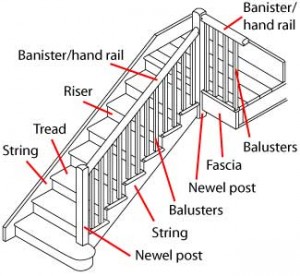11 Ways to Completely Sabotage Your staircases Sydney
The smart Trick of Types Of Stairs: 9 Best Ideas About Types Of Stairs, Stairs ... That Nobody is Discussing
Numerous examples of stairs A staircase, staircase, stairwell, flight of stairs, or merely stairs, is a construction developed to bridge a large vertical range by dividing it into smaller sized vertical ranges, called steps. Stairs might be directly, round, or might consist of 2 or more straight pieces linked at angles.
Some options to stairs are elevators (also called lifts), stairlifts and likely moving sidewalks. A stair, or a stairstep, is one step in a flight of stairs. In buildings, stairs is a term used to a total flight of steps between 2 floors. A stair flight is a run of stairs or actions between landings.
Some Known Factual Statements About How To Build Deck Stairs & Steps - Decks.com
A stairwell is a compartment extending vertically through a structure in which stairs are put. A stair hall is the stairs, landings, hallways, or other portions of the general public hall through which it is needed to pass when going from the entryway floor to the other floorings of a structure.

Stairs might be in a straight run, leading from one floor to another without a turn or modification in instructions. Stairs might alter instructions, frequently by 2 straight flights connected at a 90 degree angle landing. Stairs may likewise return onto themselves with 180 degree angle landings at each end of straight flights forming a vertical staircase commonly utilized in multistory and highrise structures.
Some Known Factual Statements About How To Calculate Stairs - First In Architecture
Stairs might be a required part of egress from structures and structures. Stairs are likewise supplied for convenience to access floors, roofings, levels and strolling surfaces not available by other methods. Stairs might likewise be a fanciful physical construct such as the stairs that go nowhere located at the Winchester Secret Home.
C. Escher. "Staircase" is likewise a typical metaphor for achievement or loss of a position in the society; or as a metaphor of hierarchy (e.g. Jacob's Ladder, The Battleship Potemkin). Steps with 2 anti-slip rubber lines and little nosings Each step is made up of tread and riser. The part of the stairway that is stepped on.
Things about Staircase Terminology - Folsom Stair & Woodworks
The tread staircase design "depth" is determined from the back of one tread to the back of the next. The "width" is measured from one side to the other. The vertical part between each tread on the stair. This may be missing for an "open" stair effect. An edge part of the tread that extends over the riser beneath.
Lots of building regulations need stair nosings for industrial, commercial, or municipal stairs. they supply extra length to the tread without changing the pitch of the stairs. Starting or function tread Where stairs are open on one or both sides, the initial step above the lower floor or landing might be broader than the other actions and rounded.
5 Easy Facts About Stair Terminology - Designed Stairs Shown
Besides the cosmetic appeal, beginning actions allow the balusters to form a larger, more steady base for the end of the handrail. Handrails that merely end at a post at the foot of the stairs can be less tough, even with a thick post. A double ended feature tread can be used when both sides of the stairs are open.
Stringer, Stringer board or in some cases simply String The structural member that supports the treads and risers in basic staircases. There are generally three stringers, one on either side and one in the centre, with more added as required for wider periods. Side stringers are often dadoed to receive risers and treads for increased support.
The Ultimate Guide To Code Check: Stair Codes For Rise, Run, And Nosing - The ...
Tread Increase The range from the top of one tread to the top of the next tread. Overall Rise The range the flight of stairs raises vertically in between two finished floor levels. Winders Winders are steps that are narrower on one side than the other. They are used to change the instructions of the stairs without landings.

When 3 steps are utilized to turn a 90 corner, the middle step is called a kite winder as a kite-shaped quadrilateral. Trim Different moldings are utilized to embellish and in some instances support staircase components. Scotia or quarter-round are typically positioned below the nosing to support its overhang. A decorative action at the bottom of the staircase which normally houses the volute and volute newel turning for a continuous handrail.
9 Easy Facts About How To Build A Staircase - The Home Depot Explained
Banister, Railing or Handrail The angled member for handholding, as distinguished from the vertical balusters which hold it up for stairs that are open on one side; there is typically a railing on both sides, often only on one side or not at all, on wide staircases there is often also one in the middle, or perhaps more.
